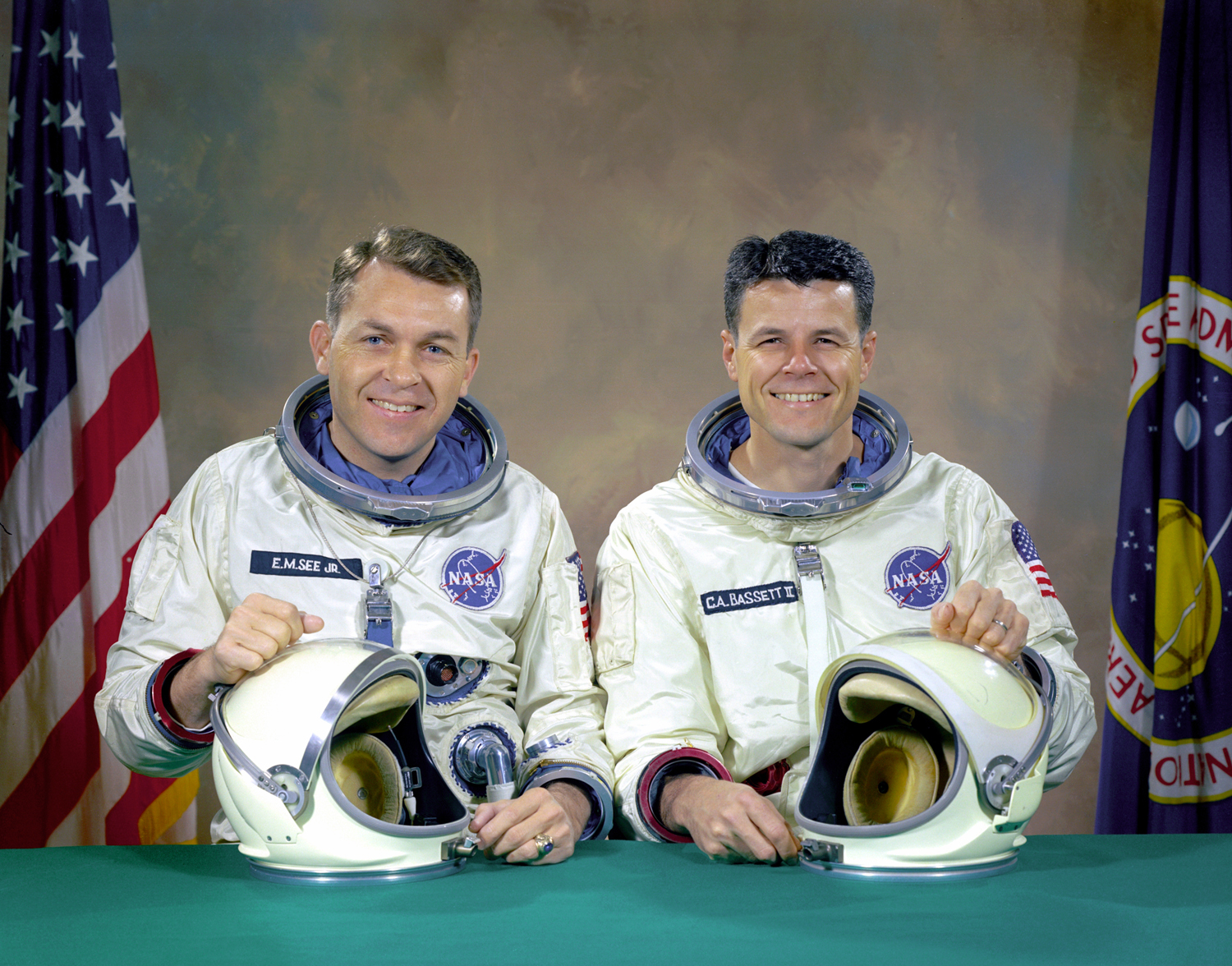
Fifty years ago, this month, in February 1966, NASA and America’s effort to land a man on the Moon before the end of the decade appeared to be on its uppers. Project Gemini had already demonstrated spacewalking, rendezvous, and flown a pair of missions lasting the minimum and maximum durations anticipated for a round-trip piloted voyage to our closest celestial neighbor. As many as five more missions were planned in 1966, beginning with Gemini VIII through XII expected to achieve physical dockings with unmanned Agena target vehicles, as well as spacewalking, orbital reboosts, and dozens of scientific experiments. Coupled with plans to launch the first crewed Apollo mission before year’s end, and test the giant Saturn IB booster for low-Earth orbit flights, 1966 was shaping up to be an ambitious 12 months. All those plans fell into disarray on 28 February—50 years ago, tomorrow—when NASA and the United States suffered the loss of the Gemini IX prime crew in an appalling aircraft accident.
That crew consisted of “rookie” astronauts Elliot See and Charlie Bassett, both of whom had been named in November 1965, along with their backups, Tom Stafford and Gene Cernan. Gemini IX was targeted to launch in May 1966, tasked with executing a three-day mission which would demonstrate rendezvous and docking with an Agena target vehicle— becoming the second mission to successfully do so, after Gemini VIII—and feature a lengthy spacewalk by Bassett. At the time of the crew announcement, Stafford was already deep into training for his first flight, Gemini VI-A, and Cernan trained alone with See and Bassett until early in 1966. Cernan’s shadowed Bassett, who would perform his EVA using an Air Force-built device, known as the Astronaut Maneuvering Unit (AMU). The latter, in Cernan’s words, resembled “a massive suitcase,” which was “so big that it would be carried aloft folded up like a lawn-chair and attached within the rear of the Gemini.”
After leaving Gemini IX’s pressurized cabin, Bassett would move to the rear of the spacecraft and “slip onto a bicycle-type seat,” wrote Cernan in his autobiography, The Last Man on the Moon, “strap on the silver-white box and glide off into space, maneuvering with controls mounted on the armrests.” The 165-pound (75-kg) AMU had evolved from Air Force research into the Manned Orbiting Laboratory (MOL) and Bassett’s EVA would see him perform extensive tests of its 12 hydrogen peroxide thrusters. It was also equipped with fuel tanks, lights, oxygen supplies, storage batteries, and radio and telemetry systems. He would control his fine movements with a pair of knobs on the AMU’s arms: one for direction of motion on the left side, the other for attitude on the right side, although he would remain attached to Gemini IX by a 147-foot (45-meter) tether throughout the spacewalk.
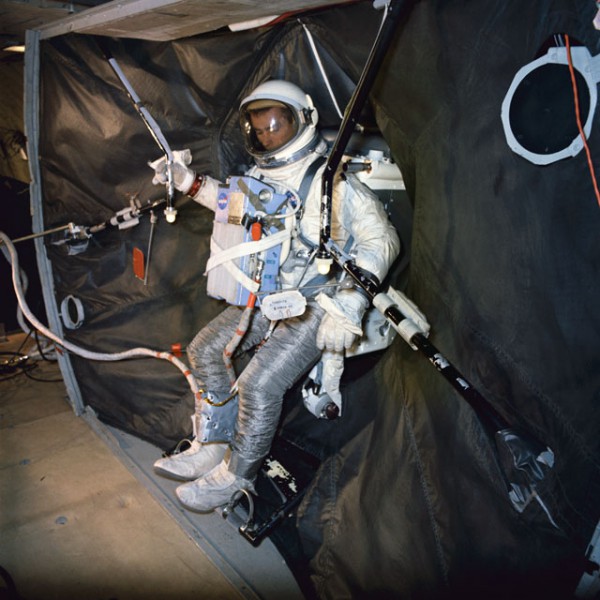
Before 1966, spacewalkers did not train in large underwater facilities and, instead, Bassett and Cernan spent much of their time physically conditioning themselves for the labor of working inside a pressurized suit. The two men recognized that vast reserves of strength and stamina were needed and they resorted to lengthy periods in the gym, as well as games of handball and hundreds of press-ups. “Before long,” Cernan wrote, “we grew Popeye-sized forearms.” The two men lived three blocks apart in Nassau Bay and Cernan related that “we found ourselves in a lot of airplanes and sharing a beer or two in hotel bars, hammering at the mission, always the mission.”
In addition to cotton undergarments for biosensors, nylon “comfort” layers, Dacron-Teflon netting to maintain shape and aluminized Mylar and nylon for thermal and micrometeoroid protection, the EVA suits required additional heat protection to guard against the hydrogen peroxide plumes from the AMU. This extra protection came in the form of 11 layers of aluminized H-film and fiberglass, topped by a metallic fabric woven from fibers of the alloy Chromel R. It was particularly important since, during the EVA, the AMU’s jets would actually fire directly between Bassett’s legs. During training, the two men watched as a technician charred the material with a blowtorch for five minutes and told them that, despite the intense temperature of the AMU exhaust, they would remain comfortable in their protective suits.
When joined by Stafford, the foursome spent so much time training together that a level of kinship developed between them. In command of Gemini IX was Elliot McKay See Jr, a deeply religious former General Electric pilot, who had performed engine testing before coming to NASA. Described by space historians Colin Burgess, Kate Doolan, and Bert Vis in their book Fallen Astronauts as “a gentle but dedicated man who went about his work with a calm efficiency,” See was the oldest of NASA’s second group of astronauts, selected in September 1962. He was born in Dallas, Texas, in July 1927, the son of a General Electric engineer, and after graduating from high school See entered the University of Texas, where he set aside money for flying lessons. It was at this stage that his fascination with airplanes crystallized into a decision to pursue a career in engineering and aviation. Receipt of his private pilot’s license, wrote Burgess, Doolan and Vis, was “a defining moment in his life.” He subsequently entered the U.S. Merchant Marine Academy at Kings Point on Long Island, N.Y., and earned a science degree in 1949.
He then joined General Electric as an engineer within the company’s aircraft gas turbine division in Boston, Mass., and later in Cincinnati, Ohio, during which time he met his future wife, Marilyn. His interest in aviation continued and he jointly purchased an all-aluminum 8-series Luscome Silvaire two-seated aircraft. During one flight, he attempted to navigate without instruments and directed the Luscombe’s nose directly into an approaching mass of cumulus cloud. “Almost immediately, he became disoriented and realized just how quickly the loss of visibility could affect one’s equilibrium and sense of direction,” wrote Burgess, Doolan and Vis. “When he finally emerged from the cloud, he was alarmed to find himself in a spiral dive, from which he quickly corrected.” Following this “sobering experience,” See was involved in an aircraft accident in 1952, which left him with a facial scar for the rest of his life.
See’s career with General Electric continued to blossom as a flight test engineer, but in 1953 he was called to active duty within the U.S. Naval Reserve, based at Miramar Naval Base in San Diego, Calif. Shortly thereafter, he married Marilyn and was assigned to a 16-month tour as part of Fighter Squadron VF-44, followed by duty in the Mediterranean Sea, as a line maintenance officer aboard the USS Boxer, during which he flew the high-performance F-9F-5 Panther. By the end of his Naval Reserve duty in 1956, See had attained the rank of lieutenant-commander and had qualified as an operational jet aviator, and, in February of that same year, he and Marilyn became the proud parents of a daughter, Sally.
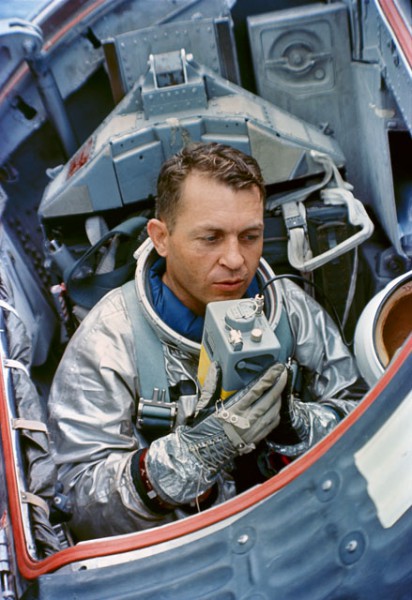
He resumed his General Electric career as a group leader and experimental test pilot in Lancaster, Calif., working at nearby Edwards Air Force Base on aircraft such as the F-86 Sabre, the F-104 Starfighter, F-4H Phantom, and the T-38A Talon. See also served as project pilot for the J79-8 jet engine evaluation program, in conjunction with the F-4H, which saw him assisting the project engineer and flying most of the F-4H missions. A second daughter, Carolyn, joined the See family in November 1957, as her father continued his work on powerplant test flights of a range of aft-fan aircraft engines. Additionally, he flew for the Los Angeles Naval Reserve Unit and attended classes in engineering at the University of California at Los Angeles, earning a master’s degree in 1962.
That same August, his family was completed with the birth of their son, David, and in September See was selected as one of nine astronaut candidates by NASA. Together with Neil Armstrong, he became one of the first civilians ever selected by the space agency for astronaut training. “Overwhelmed isn’t the right word,” See recounted, upon learning of his selection. “I was amazed and certainly pleased. It’s a very great honor.” When the time came to report to the Manned Spacecraft Center (MSC)—today’s Johnson Space Center (JSC)—in Houston, Texas, he did so in the company of Armstrong. “I don’t remember whether the car was his or mine,” Armstrong recalled, as quoted by Burgess, Doolan, and Vis. “If it was his, it would have been a convertible; he loved convertibles. He was enjoyable company; we enjoyed being together and wondering what our future would be.” As circumstances transpired, their futures were closely intertwined. In February 1965, the pair were named as the backup crew for Gemini V, which eventually flew the following August, after which both men were assigned to their first flights: Armstrong commanding Gemini VIII, See commanding Gemini IX. In doing so, See would become only the fourth U.S. astronaut in history to command a crew on his very first spaceflight.
His partner on Gemini IX was Charles Arthur Bassett II, born in Dayton, Ohio, in December 1931. Described by Burgess, Doolan, and Vis as “patently outgoing,” he came from a long line of American ancestors, his forebears having arrived in November 1621 aboard the Fortune, which was the second ship to arrive at Plymouth, Mass., after the Mayflower. Bassett was the son of a career U.S. Army engineering officer and after his early education, he entered Ohio State University, then enrolled in the Reserve Officers Training Corps (ROTC) as an aviation cadet. Graduating from Bryan Air Force Base, near Bryan, Texas, in 1953, he was commissioned into the Air Force and later flew the T-6 Texan, T-28 Trojan, and T-33 Shooting Star. He proceeded into advanced F-86 Sabre training, which he flew in Korea with the 8th Fighter-Bomber Group. Returning to the United States in 1955 as a first lieutenant, he flew the F-86, the F-102 Delta Dagger, “and just about anything else with wings,” prior to assignment to an electrical engineering course through the Air Force Institute of Technology at Wright-Patterson Air Force Base, near Dayton. He completed his studies at Texas Technological College in Lubbock and gained a degree in 1960.
Graduation was followed by promotion to captain and a period of engineering work at Edwards Air Force Base, after which he attended Squadron Officer School at Maxwell Air Force Base in Montgomery, Ala., worked as a test engineer and entered the Air Force Experimental Test Pilot School. In his private life, he had married Jeannie in June 1955 and they had two children: a daughter, Karen, born in December 1957, and a son, Peter, in April 1961. A year later, Bassett graduated from test pilot school—receiving the A.B. Honts Award for “overall first standing in the class” and the Empire Test Pilot School Award “for the top student in academics”—and undertook flight test work at Edwards. He later attended advanced test pilot school, alongside fellow astronauts-to-be Mike Collins, Ed Givens, and Joe Engle. As he completed Aerospace Research Pilot School, he also worked on the classified SR-71 Blackbird strategic reconnaissance aircraft, before being selected as a NASA astronaut candidate in October 1963.
Less than two years later, Bassett and See came together as the prime crew for Gemini IX. “Oh, really?” was Marilyn See’s excited response, when her husband came home one day in October 1965 and told her that he would be commanding the mission. As for Bassett, he hugged his wife, Jeannie, so hard that, in the words of Burgess, Doolan and Vis, “she knew he had heard some exciting news.” The official announcement from NASA came on 8 November. “Officially, the two- to three-day voyage was scheduled for sometime after 1 July 1966,” noted Burgess, Doolan, and Vis, “but Bassett had been told it could begin as early as May, if all went well.”
One day in 1965, “rookie” astronaut Walt Cunningham flew backseat in a T-38 flight with See, who wanted to fly over Taylor Lake in Texas’ Harris County and buzz his house. At one stage, with a full load of fuel, See brought the jet to an altitude of 50 feet (15 meters), an airspeed of 170 knots, and no flaps down. “The T-38 with a full load of fuel won’t fly a whole lot slower than 165 knots, even with the flaps down,” Cunningham recalled in his memoir, The All-American Boys. “The fact that he was flying way too slow troubled me only to the extent that it could get me killed.” At length, Cunningham called “Hey, how about half-flaps” and See concurred, dropping half flaps, waving to his wife, and flying away.
That hair-raising episode would be brought home to Cunningham with a horrifying sharpness, less than a year later, on 28 February 1966.
The second part of this article will appear tomorrow.
Be sure to “Like” AmericaSpace on Facebook and follow us on Twitter: @AmericaSpace




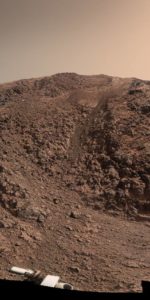
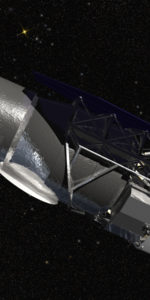
That’s an interesting bit from Walt Cunningham about Elliot See pulling a daredevil stunt to buzz his house, since it goes contrary to the usual image of See as excessively cautious.